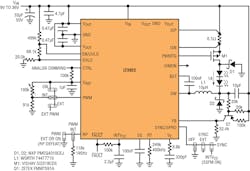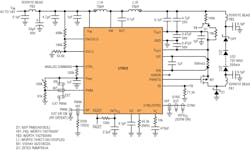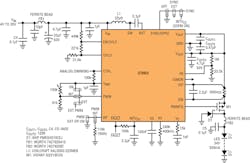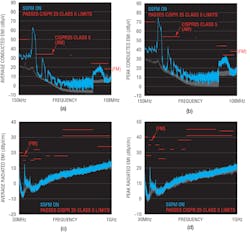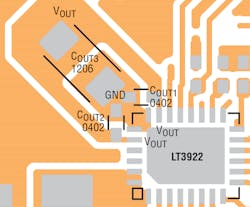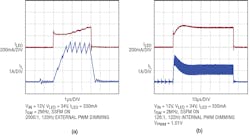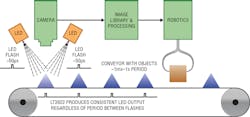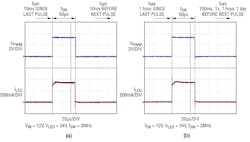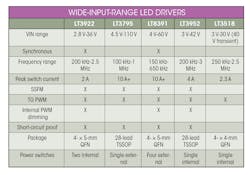Low-EMI LED Driver Features Integrated Switches, Internal PWM Dimming
This article is part of the Power Management Series: Driving LED Designs
Members can download this article in PDF format.
What you'll learn:
- How a single LED driver can support buck, boost, and buck-boost topologies.
- Design details for each topology type.
- How such drivers work in automotive and machine-vision designs.
The breadth of LED applications has grown to encompass everything from general lighting to automotive, industrial and test equipment, sign boards, and safety equipment. As a result, it's expanded the design requirements for LED drivers. Engineers must meet these requirements with high efficiency, low noise, and in a compact form factor while providing features like high dimming ratios and advanced fault protection.
So much about LEDs make them ideal for use in automotive lighting. There's a visual appeal of LED tail and daytime running lights. Efficient LED headlights are robust, with lifetimes orders of magnitude longer than their relatively burn-out-prone filament-based predecessors.
Drivers need to be small and efficient with wide input and output voltage ranges, and should feature low EMI, high efficiency, and fault protection as required in automotive environments. Controlled switching edges power LEDs with low EMI. Built-in flexibility and fault protection reduce the number of required components to protect against short and open LED strings.
A flexible LED driver also will support different topologies. A single driver that can operate in boost, buck, and boost-buck modes can drive exterior daytime running lights, signal lights, tail lights, and headlight segments as well as interior dashboard and head-up displays with high dimming ratio.
Choice of Topologies: Boost, Buck Mode, Buck-Boost
LED strings are driven by a controlled current that doesn't need to be returned directly to ground. Both LED+ and LED−, or either one, can be attached to non-ground potentials. This opens up the field of options for floating output dc-dc LED driver topologies, including buck mode (step-down) and boost-buck (step-up and step-down). By selecting an LED driver that can be configured as a boost, buck or boost-buck LED driver, engineers can keep their options open and simplify design across multiple designs.
For example, the high-side PWMTG driver and synchronous switches of the LT3922 36-V, synchronous LED driver can be configured as a boost, buck mode or boost-buck LED driver. At the same time, the driver retains all of its features: internal pulse-width-modulated (PWM) dimming, spread-spectrum frequency modulation (SSFM), low EMI, ISMON output-current monitor, and output fault protection carry over from the standard boost topology to the buck mode and boost-buck mode.
Boost
Figure 1 shows a flexible LED driver being used as a boost converter operating a 2-MHz, 4- to 28-V boost. In this case, the LED driver can power LEDs up to 34 V, leaving some headroom below 40 V for open LED overshoot. In Figure 1, the LED driver powers a 330-mA string of LEDs at up to 34 V. It can be externally PWM dimmed at 120 Hz to a 2000:1 ratio or internally dimmed to 128:1 ratio with an analog input voltage on the PWM pin.
It survives open LED and LED+-to-ground short-circuits and reports these faults by asserting its FAULT pin. The output current can be monitored via the ISMON pin, even during PWM dimming. At 2-MHz switching frequency, its fundamental EMI harmonic resides above the AM band, but its EMI is still low. SSFM can be added to spread the switching frequency between 2 to 2.5 MHz and reduce the EMI at the fundamental and its many harmonics.
The efficiency of the 2-MHz boost converter remains as high as 91% at 12 VIN due to the integrated synchronous switches. At lower VIN, when the peak inductor current hits its limit, the output current is gracefully reduced without flicker while the LEDs remain on.
Buck
Figure 2 shows a buck-mode topology where the input voltage can be as high as 36 V and a string of LEDs can be driven at up to 1.5 A. The high-side ISP and ISN current-sense input and PWMTG PMOS driver are easily moved to the high side of the LEDs, which is connected to the input in buck mode. LED− is connected directly to the inductor and not to ground.
When driving two, 1-A LEDs at 6.5 V, the synchronous buck-mode efficiency is as high as 94% at 12-V VIN and remains as high as 89% at 36-V VIN. The high bandwidth of the buck-mode converter allows it to work with a 1000:1 PWM dimming ratio at 100 Hz.
Buck-Boost
Figure 3 shows a boost-buck topology that supports an input voltage range extending above and below the LED string voltage. The sum of the LED string voltage and the input voltage must remain below 35 V to keep the ISP and ISN voltage below the 40-V absolute maximum.
The LED driver has a low-EMI topology that features a boost-type low-ripple input inductor and a buck-mode-type low-ripple output-facing inductor. A 4 -to 18-V automotive input or multiple battery chemistry input (5 V, 12 V, and 19 V) boost-buck converter can drive an LED string voltage anywhere between 3 and 16 V.
As in the other topologies, the PWMTG driver simplifies PWM dimming MOSFET connection. Open- and short-circuit protection aren't compromised in the floating LED topologies. An optional diode on LED− protects against LED-to-GND short-circuits.
The 2-MHz converter in Figure 3 features 85% efficiency (87% without EMI filters) at 12-V VIN, 15-V VLED, 330-mA ILED, and up to 2000:1 PWM dimming ratio at 120 Hz. This solution fits the requirements of an automotive daytime running light, signal light, or tail-light LED driver due to its size, versatility, and low EMI.
The 400-kHz automotive boost LED driver in Figure 4 passes CISPR 25 Class 5 EMI tests (Fig. 5), which shows conducted and radiated EMI test results of the LT3922 along with class 5 EMI limits. This is a result of a combination of low EMI capabilities such as controlled switching edges and SSFM that reduces power-switch high-frequency EMI without degrading efficiency and power capability.
SSFM in the LT3922 spreads the resistor-set switching frequency up and down from 100% to 125% of its value at a rate of 1.6 kHz for the 400-kHz converter. This decreases both the peak and average EMI in the converter at low and high frequencies. The feature is easy to turn on and off by connecting the SYNC/SPRD pin to INTVCC or GND, respectively. High-frequency ringing also can be eliminated by internal synchronous switches that minimize hot-switching-loop size and control switching edges.
Figure 6 shows how placement of small, high-frequency capacitors near the two VOUT pins minimize hot-loop size and EMI. Of course, proper layout and a small amount of ferrite-bead filtering (FB1 and FB2) should be used for best EMI results.
Internally Generated PWM Dimming
Analog dimming via adjustable voltage on the CTRL pin has always been easier to implement than the more accurate PWM dimming. Until now, PWM dimming required an external clock or micro signal whose duty cycle controlled the brightness via the PWM input pin. LED drivers with an internally generated PWM dimming signal only require an external voltage on the PWM pin to set the duty cycle for 128:1 PWM dimming. The PWM period, such as 122 Hz, is set by a single resistor on the RP pin.
LED current accuracy is a necessity for vehicles with redundant light clusters. The brightness of both sides must match for obvious reasons. Identically manufactured LEDs can produce different brightnesses at the same drive current. Internal dimming capabilities of the LED driver can be used for brightness trimming near or just below 100% duty cycle and then set to accurate 10:1 or 100:1 ratios. This may save the light cluster manufacturer from paying extra for specially binned LEDs.
When higher dimming ratios are needed, the LED driver can be externally dimmed in the usual manner. The high-bandwidth, 400-kHz buck-mode LED driver in Figure 2 yields a 1000:1 PWM dimming ratio at 100 Hz.
The 2-MHz boost LED driver in Figure 1 can achieve 2000:1 dimming ratio at 120 Hz (Fig. 7a). The same circuit can be set up for internally generated PWM dimming by placing a 122-Hz frequency resistor on the RP pin and setting the PWM pin voltage between 1.0 and 2.0 V for up to 128:1 dimming (Fig. 7b). For example, the LT3922 LED driver can be set up to run with up to 5000:1 external PWM dimming in some applications, and PWM dimming can be combined with the LT3922’s analog dimming for over 50,000:1 brightness control.
Machine Vision
In industrial assembly-line applications, machine vision (Fig. 8) provides rapid visual feedback of devices using high-speed digital photography in conjunction with digital image processing. This helps rapidly identify and isolate defective products with little or no human inspection. The lighting used for machine-vision systems must be synchronized with the speed of the assembly-line processes while maintaining the ability to produce a consistent pulse of light for an indefinite period of off-time.
Conventional LED drivers are unable to maintain their output voltage after the PWM input signal is held low for any sustained amount of time. This is due to the gradual discharge of the output capacitor, making generic LED drivers unsuitable for most machine-vision applications.
By digitally sampling the output state of the converter during the falling edge of the PWM signal, an LED driver can maintain its output voltage during prolonged off-times. It performs “maintenance switching” during the PWM off-time while the LEDs are disconnected by the high-side PMOS. During standard PWM dimming at frequencies above 100 Hz, the longest off-time is 10 ms or less, and not much leakage current can be pulled off the output at that time. Machine-vision and strobe applications can have long off-times between 100 ms and 5 seconds (or longer), allowing for tens to hundreds times more leakage.
Maintenance switching ensures that the output capacitor maintains the voltage recorded during the LED driver’s previous sample cycle. The digital sample of the state of the converter is stored indefinitely, assuming uninterrupted input power is provided to the IC. This allows the driver to have a consistent output-current waveform for any given off-time (Fig. 9).
As the range of LED applications continues to increase, so must the versatility of LED drivers. With an LED driver that can be easily used in boost, buck and boost-buck topologies, engineers can simplify design, reduce form factor size, and increase efficiency (see table).
Regardless of topology, all capabilities are available, including high PWM dimming capability and internally generated PWM dimming. Low EMI is easily achievable with internal functions including SSFM.
This article is part of the Power Management Series: Driving LED Designs


